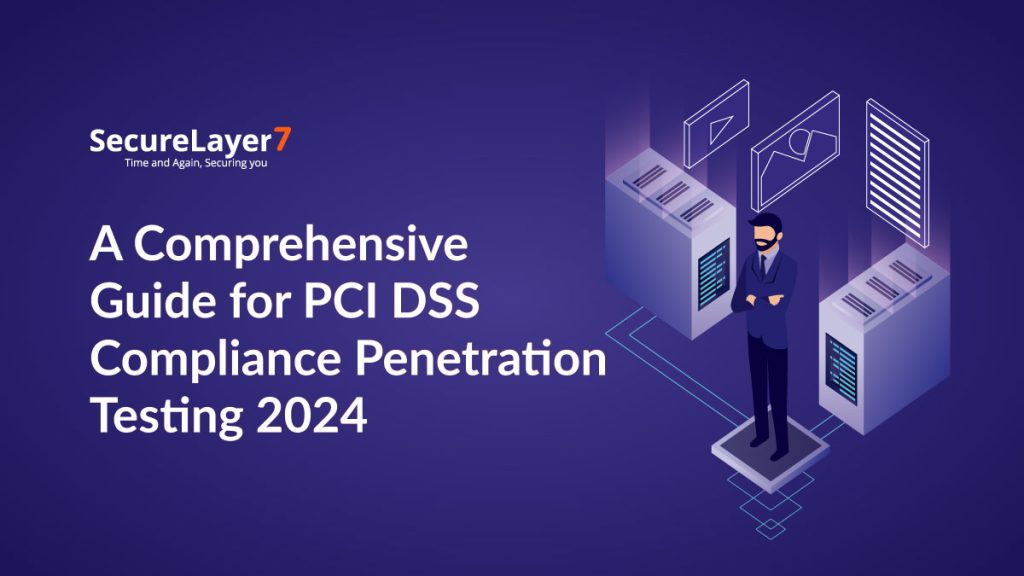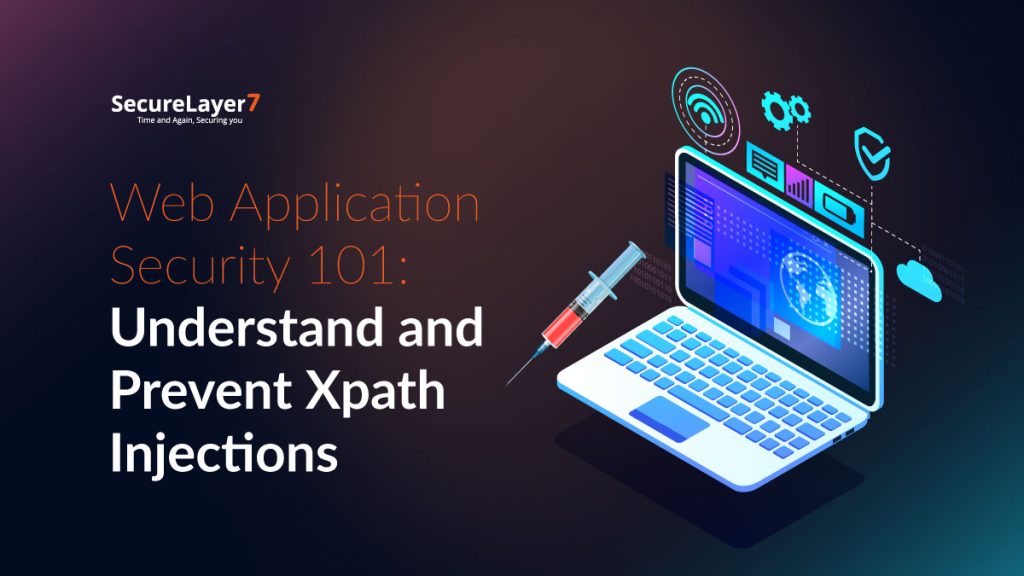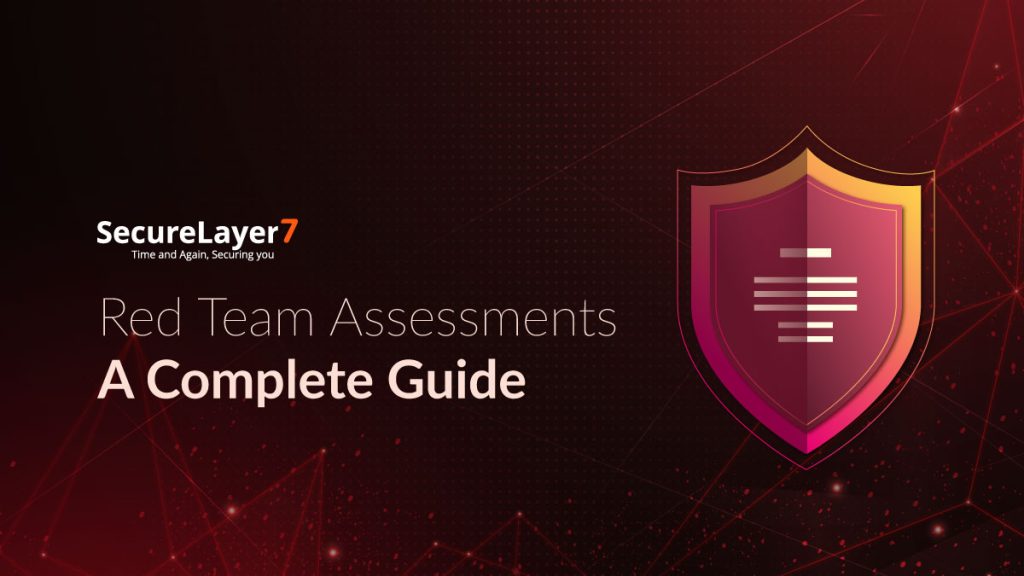
The Ultimate Guide to Choosing the Best Red Team Assessment Partner
April 17, 2024
A Comprehensive Guide for PCI DSS Compliance Penetration Testing 2024
April 30, 2024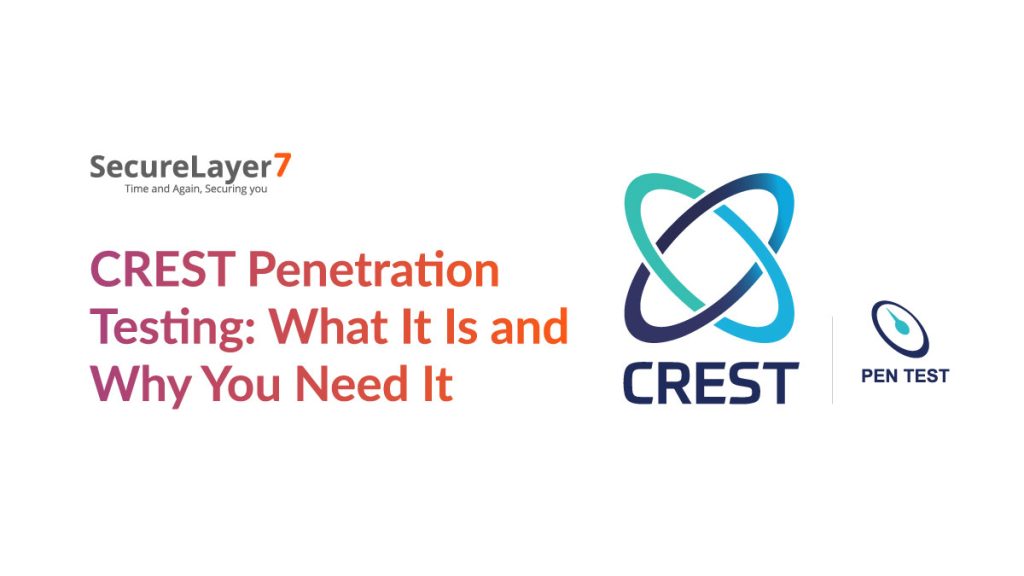
Corporations have invested significant resources over the years to bolster their IT asset security. However, hackers have continuously evolved their techniques, posing a formidable challenge to cybersecurity. This has led to an ongoing race between the two, with threat actors quickly adapting to counter any defense.
For example, Multi Factor Authentication (MFA) was initially praised as a robust defense against weak passwords. However, malicious actors have devised ways to bypass it using social engineering to steal authentication codes.
It reflects the increasing sophistication and adaptability of cyber threats. That’s where CREST penetration testing comes into play. It helps organizations to fill the security gaps before they become breaches.
This article digs deeper to explore CREST penetration testing, its advantages, and how it’s conducted.
What is Penetration Testing?
A penetration test, or pen testing, is a method of conducting simulated cyber attacks to identify security vulnerabilities and mitigate security risks. This involves testing applications, IT networks, APIs, servers, and computer systems to uncover hidden vulnerabilities, such as code injection, weak passwords, misconfigurations in firewalls, insecure network protocols, and application layer vulnerabilities.
These insights help identify vulnerabilities and weaknesses to mitigate threats, strengthening overall security, processes, and policies.
Types of Penetration Testing
There are several types of penetration tests; each serves its own distinct objective. They broadly fall into the following categories:
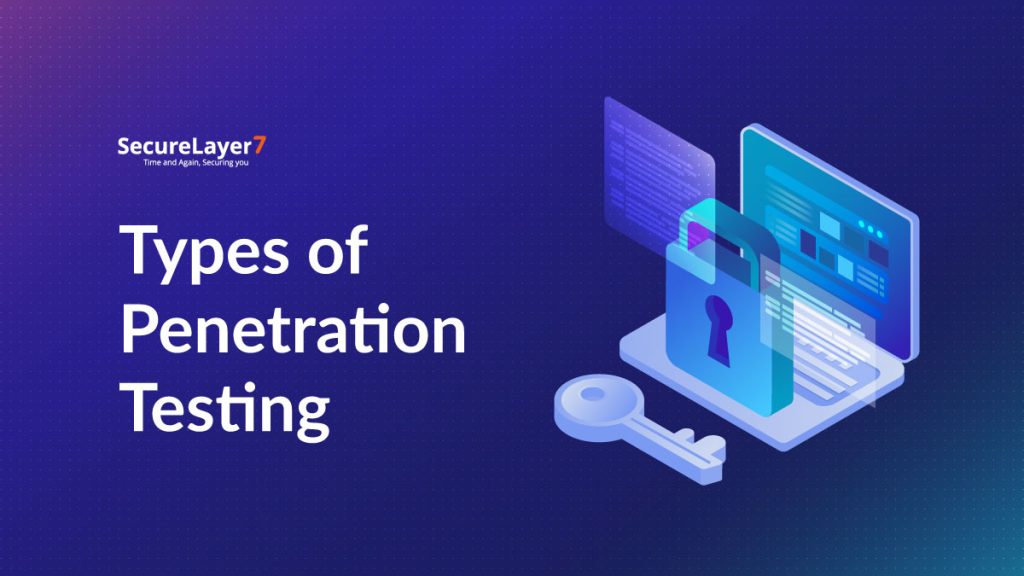
Network Penetration Testing
As the name suggests, network penetration tests aim to identify weaknesses in the IT network infrastructure, be it on-premise or in a cloud environment. Network penetration tests are ideal for cloud-based companies.
Mobile Penetration Testing
Popularly known as mobile pen testing, it targets mobile applications to identify security weaknesses. For companies developing gaming applications, payments, and shopping carts, mobile penetration testing is an ideal solution. It allows them to test security loopholes in the application before releasing them in the market for public consumption.
API Penetration Testing
Nowadays, businesses rely on multiple APIs to deliver services, thereby expanding the attack surface. API penetration testing aids in identifying potential vulnerabilities across various types of APIs, including REST, SOAP, and GraphQL. Companies that use applications to deliver services should regularly conduct API penetration testing to safeguard their applications from potential vulnerability exposures.
Cloud Penetration Testing
Also known as cloud pen testing, cloud penetration testing involves conducting cyberattacks on an organization’s cloud-based applications and infrastructure, including data storage and networks used for data transfer. It is particularly effective for companies that provide cloud services, such as AWS, Google Cloud Platform, Azure, and cloud security services.
Social Engineering Penetration Testing
Social engineering penetration testing involves creating scenarios in which bad actors trick employees into providing access to sensitive information. This type of testing is specifically useful for organizations seeking to assess their employees’ security awareness and readiness.
Automated Penetration Testing
Also known as phishing assessments, this method involves automated tools for simulating attacks and identifying hidden vulnerabilities in systems. Automated scanning is beneficial as it can rapidly detect a large number of vulnerabilities in systems.
Understanding CREST Penetration Testing
CREST refers to ‘the Council of Registered Ethical Security Testers,’ a not-for-profit accreditation body that sets cybersecurity penetration testing standards. It ensures that the quality of penetration testing services meets the highest legal and ethical standards.
This certification and methodology are internationally recognized and utilized by reputable companies striving for excellence in penetration testing.
CREST certification validates the quality of a company’s pen testing service. Therefore, it makes sense to engage with CREST-certified companies.
Why CREST Penetration Testing Matters
Collaborating with CREST-certified testers instills confidence in businesses regarding the quality of penetration tests conducted by skilled security professionals. These professionals adhere to rigorous standards and best practices while appropriately managing risks. This confidence and trust stem from the meticulous processes CREST follows in awarding certification.
Attaining CREST accreditation entails meeting stringent criteria that encompass operating procedures, standards, and best practices for penetration testing. Companies must maintain meticulous documentation, including insurance certificates and sample client contracts to achieve accreditation. Additionally, they need to obtain necessary compliance certificates, such as ISO 27001, ISO 9001, and SOC2.
CREST Penetration Testing Vs. Other Penetration Testing Methods
| Aspect | CREST Penetration Testing | Other Penetration Testing |
| Accreditation | Follows rigorous assessment process and adheres to the highest standards in pen testing | May not have a specific focus on penetration testing |
| Ethical Standards | Adheres to the strict codes of ethics, ensuring responsible and ethical conduct in security testing | Lack similar level of emphasis on ethical standards in pen testing |
| Global Recognition | Globally recognized certification, assuring the quality and credibility of organization, irrespective of the organization’s location | May not enjoy global credibility and acceptance |
| Regulatory Compliance | Recognized by regulatory bodies for its industry standards and compliance needs. It helps companies seeking to meet OWASP and NIST compliance. | They are generally not as stringent. |
What Sets CREST Penetration Testing Apart
CREST-accredited service providers offer advantages in several ways. including:
- Quality and Credibility: CREST accreditation helps meet the rigorous quality standards in cybersecurity service delivery.
- Skilled Testers: Obtaining CREST certification is no easy feat. Professionals must pass multiple examinations to demonstrate their ability to apply skills in real-world scenarios.
- Consistent Approach: CREST penetration testing providers are required to adhere to a defined standard methodology that meets the highest industry standards, ensuring a consistent and reliable testing approach.
- Regulatory Alignment: CREST empowers organizations to meet mandatory compliance requirements, such as GDPR, HIPAA, and PCI DSS.
- Minimizes False Positives: This accreditation ensures that testers can distinguish between genuine vulnerabilities and false positives. Internal reviews by senior testers add an extra layer of scrutiny.
The Process of CREST Penetration Testing
Below is a comprehensive, step-by-step guide outlining the process of CREST penetration testing process for vulnerability assessment:
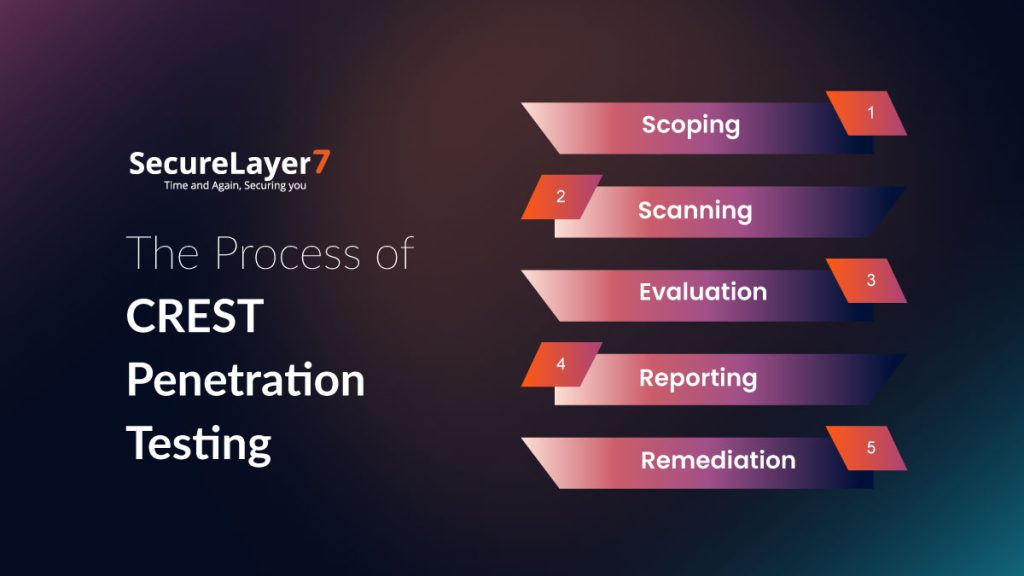
1. Scoping
During the scoping phase, the vulnerability assessment provider compiles a list of IT assets slated for auditing in the penetration testing process. Additionally, the penetration testing company establishes assessment rules and endeavors to understand clients’ requirements.
Thorough scoping enables penetration testers to grasp the context of the applications under test. It entails comprehensive documentation of parameters and vulnerabilities, reducing the likelihood of unexpected costs or disruptions during testing. Scoping serves several purposes:
- Identifying the most critical data and business concerns to address during the test.
- Delimiting the security boundary for each penetration test.
- Defining the scope based on specific business risks, such as network security.
- Ensuring that testing aligns with the organization’s budget and security needs.
- Scanning
In the scanning phase, CREST-certified pen testers thoroughly scan every audited asset identified in the first stage. This includes a thorough examination of security controls, configurations, and compliances to ensure all potential security threats are identified and addressed.
3. Evaluation
Now, in the third stage, the vulnerabilities discovered in the scanning phase are categorized based on the severity level of the threats. This is achieved by assigning a score between 1 and 10, known as the Common Vulnerability Scoring System (CVSS) score.
- A CVSS score between 8-10 is considered serious, requiring critical and urgent attention.
- Scores ranging between 5-7 indicate a medium-level vulnerability.
- The score between 1- 4 indicates low-level vulnerabilities.
4. Reporting
Post-evaluation, the penetration testing team prepares a detailed report based on their finding. This may include the following:
- Detailed findings of vulnerabilities discovered
- A list of pieces of evidence supporting the successful exploitation of vulnerabilities
- Detailed remediation measures to address weaknesses
- An executive summary containing key findings and recommendations for senior management and other stakeholders
5. Remediation
The report comprises remediation measures for the threats identified during the scanning process. Vulnerabilities having a high CVSS score need to be patched urgently.
How SecureLayer7 Can Help
At SecureLayer7, our goal is to strengthen your organization’s security environment. By choosing us for CREST penetration solutions, you benefit from the expertise of certified professionals, a proven penetration testing approach, global experience, and cutting-edge tools.
Our Key USPs include:
- CREST-approved methodology: At SecureLayer7, we follow CREST-accredited methodologies to protect your IT assets from vulnerabilities in real time.
- One-stop solution for all cybersecurity needs: SecureLayer7 provides comprehensive coverage for all penetration testing needs, including web and mobile application vulnerability assessments, cloud infrastructure penetration testing, source code audits, IoT device security, social engineering assessments, red team assessments, wireless security assessments, and more.
- Hybrid approach: We use a combination of manual and automated vulnerability assessment for pentesting. This approach enables us to minimize false positives and find security gaps early.
- Certified security professionals: We have a diverse talent pool of CREST-certified practitioners, analysts, and testers ready to meet all penetration testing needs.
- Global recognition and certification: Being a Gartner-recognized company ensures that our clients benefit from the latest industry insights and best practices.
- Tailored solutions: We offer customized solutions for businesses of all sizes across the globe.
- Cutting-edge in-house tools: We use an in-house PTaaS platform and other testing tools for timely and accurate identification of cyber threats.
- Global certifications: Being SOC2 Type II, CREST, CERT certified reflects our commitment to quality and compliance.
Are you looking for a reliable CREST penetration company to secure your IT systems? Get in touch with SecureLayer7 experts to elevate your security posture.
Conclusion
Threat actors continue to develop more creative and effective methods to infiltrate IT networks and systems worldwide. The threat is magnified as corporations and institutions increasingly rely on third-party software and APIs to facilitate daily operations.The benefits of CREST accreditation go beyond technical excellence, encompassing various aspects of operations such as customer service, commitment to quality, and well-documented reporting. By partnering with CREST-accredited providers, organizations can access a rigorous penetration testing process, expert insights, and regulatory compliance. CREST accreditation has set the gold standard in the cybersecurity industry.
